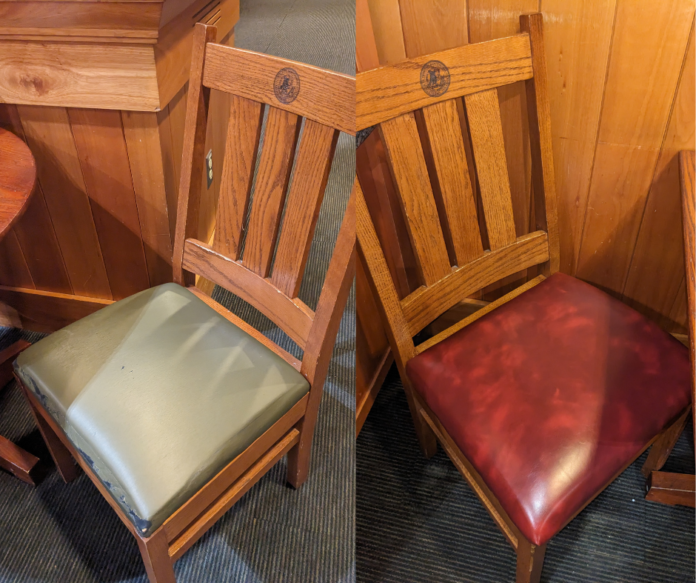You may have noticed the gradual decor change taking place in the Wood Dining Commons over the past few weeks; the seats of the chairs are slowly being re-covered, and in the process changed from green to a traditional Muhlenberg Red. If this is the first time you’re hearing about this, let me open your eyes to an issue that has never left my mind over the course of my many—too many, one might say—years of being a student at Muhlenberg, one that goes far beyond The Wood Dining Commons.
The chairs being unceremoniously carted away, only to reappear in a few hours with a brand new look may seem like a simple change; an update in style and durability to an integral piece of Muhlenberg’s infrastructure. In actuality, this may be the beginning of the end to a part of our identity of Muhlenberg College that has thus far gone nearly completely unacknowledged by faculty, staff and students. It’s time to break our silence, and finally talk candidly about this cultural taboo before we risk losing it forever: Muhlenberg’s unofficial third school color.
Sage, olive, laurel—whatever you want to call it; the kind of muted, vaguely pukey green is all over the interiors of our campus. The carpets in the CA, a few easy chairs in Java—you guessed it, the old seats of the dining hall chairs—even some walls are painted in this non-color. Yet, if you have the audacity to bring it up to anyone, you’re met with confused looks and choruses of “what do you mean? What unofficial third color?” For years I have been made to feel as though I were crazy, but today I risk my journalistic credibility to finally speak out on this issue before it is too late.
The Green was first brought to my attention by former Theatre Professor Curtis Dretsch way back in ye olde 2020. He referenced it in its capacity as the carpet in the Baker Theatre and the CA at large. If I recall correctly, he attributed the color choice to the architect of the CA, though I’m not sure if he gave a reason for this decision. I am far from your average conspiracy theorist, but I find it interesting that the first and only reference to The Green that anyone I know of has made to the student body was made by a professor who very soon thereafter “retired.”
Could this be our own “Go Away Green,” the color Disney paints things it wants to discourage park-goers from looking at? Or, is it something more sinister? Is there a history behind The Green? It’s impossible for the casual observer to say when it began to take over campus, with the variety of building interiors it lurks in and after so many have been slowly redecorated over the years. Interestingly, it is present in the Fahy Commons, our newest building—which only opened in winter 2023. Why include The Green only to begin erasing it a semester later? What happened between then and now to make them want—need—to get rid of it?
The dining hall chairs are the perfect place to start if they want the change to go unnoticed. We use them everyday, but so rarely take the time to really look at them. Even I—someone particularly attuned to The Green’s presence on campus—took long enough to notice that half the chairs had already been replaced.
I don’t know what the future holds for The Green. I don’t know why it’s being replaced. What I do know is that there’s more here than meets the eye, and if we want the chance to stop it before we lose our unofficial third color forever, we have to break our silence. It may be ugly, it may make absolutely no goddamn sense—but it’s ours, and I think it’s worth fighting for.
Lily Magoon '24 is an English major who, in addition to working on the Weekly, serves as co-editor-in-chief of the Muhlenberg Academic Review through the Sigma Tau Delta English Honor Society. She has the passionate belief that storytelling, in all its forms, is our most valuable asset--as a tool for sharing knowledge, bringing people together, creating change, and exploring what’s possible.























Philip Johnson may or may not have specified green for the CA carpet. It does not matter. Johnson’s design called for a limestone exterior but the mule chiefs decided brick would be cheaper. Johnson also specified white plaster walls for the interior and that was ignored as well. Johnson diid not even come to the defication and opening of the building. The Elis at Yale treated him much better when he designed buildings as they were building out their Science Hill area.